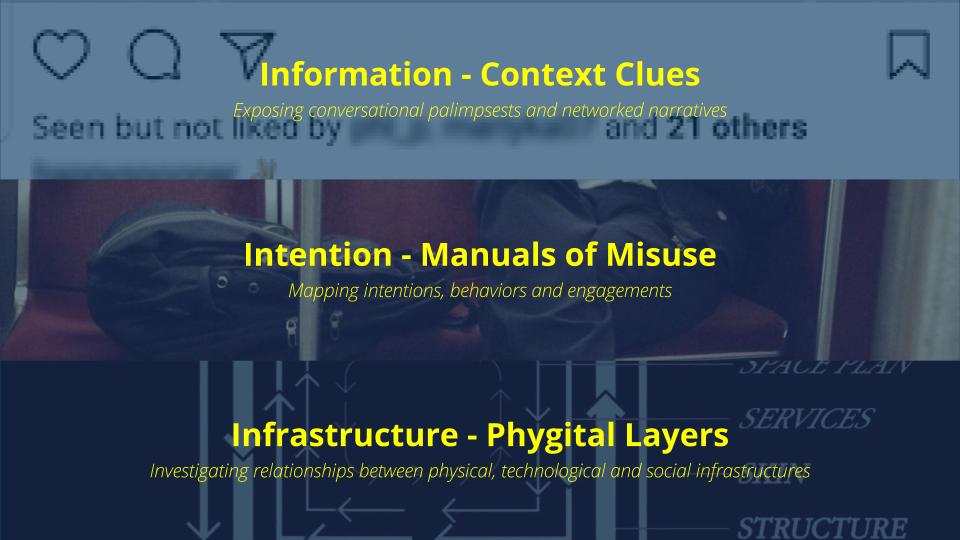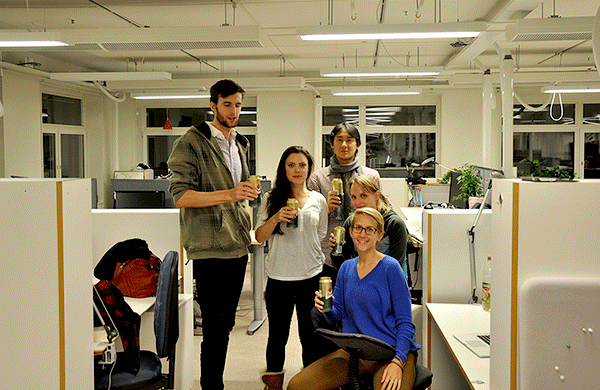Category: Technology
CHI 2018 – Attending Workshop on HCI Outdoors
This year I’ll be going to CHI 2018 as a student volunteer and to attend the workshop HCI Outdoors: Understanding Human-Computer Interaction in the Outdoors. Very much looking forward to connecting with the HCI outdoors community for a new research project!

A Walk in the Woods: Gear and Infrastructure in the Outdoors (position paper PDF)
In this position paper, we describe an initial research activity, a short walk in the woods, to position our interest in HCI and the outdoors. We present three preliminary reflections from our hike on relationships with gear and infrastructure that enable meaningful outdoor experiences. These include parallels between packing gear and preparing devices, contrasting notions within bodily comfort and brand allegiance, and safety bubbles enabled by actual or expected infrastructures.
AAAI 2018 – Accepted Spring Symposia Papers
Two papers were accepted to the AAAI 2018 Spring Symposia: Design Methods to Investigate User Experiences of Artificial Intelligence for The UX of AI symposium and The Smart Data Layer for Artificial Intelligence for the Internet of Everything symposium. I’ll be presenting the former at Stanford at the end of March, bellow is the abstract.

Design Methods to Investigate User Experiences of Artificial Intelligence
This paper engages with the challenges of designing ‘implicit interaction’, systems (or system features) in which actions are not actively guided or chosen by users but instead come from inference driven system activity. We discuss the difficulty of designing for such systems and outline three Research through Design approaches we have engaged with – first, creating a design workbook for implicit interaction, second, a workshop on designing with data that subverted the usual relationship with data, and lastly, an exploration of how a computer science notion, ‘leaky abstraction’, could be in turn misinterpreted to imagine new system uses and activities. Together these design activities outline some inventive new ways of designing User Experiences of Artificial Intelligence.
DIS 2017 – Workshop on People, Personal Data and the Built Environment
Yesterday I attended the workshop Workshop on People, Personal Data and the Built Environment at DIS 2017. Was incredibly inspiring and perhaps the best workshop format I’ve experienced as of yet! Below is my position paper.

Implicit Interaction: Information, Intention and Infrastructure (position paper PDF)
In this position paper I present three in-progress design projects that are initial explorations into Smart Implicit Interaction, which is investigating data as a design material and a new paradigm of interaction for the Internet of Things. The first project, Context Clues, critically examines our existing interactions and exchange of implicit information across digital mediums. The second project, Manuals of Misuse, is an Internet of Things design brief in which students are exploring the peripheral intentions embedded within everyday objects to design novel connections while exposing hidden patterns of behavior and engagement. The third project, Phygital Layers, is an architectural study seeking to understand the implicit relationships between physical, technological and social infrastructures within domestic environments. While all three projects differ across scale and medium, they offer potential avenues of investigation into designing for people, data and the built environment.
Innovation through Action
Part of my role within the Innovation & Design Team at Zebra Technologies involves synthesizing emerging technology trends into actionable insights. Much like many innovation teams, this yearly process involves concurrent stages of research, collection, and synthesis into pervasive and strategic themes. But as we internally transition external insights into internal action, I’ve been reflecting on our innovation process.
The top diagram represents an existing process, that from my knowledge is perhaps also representative of many other organizations. External inspiration enters an internal cycle of prescriptive stages – ex: collection, synthesis, ideation, business buy in – then, external publication, collaboration, or outreach.
But perhaps the approach should be inverted – and external publication, collaboration, and outreach come sooner and throughout. For example, involving academic collaboration, professional hackathons, and innovation challenges

WIAD16 Bristol – Making the Invisible Physical
Below is the loose script and slides from a 20 minute talk I gave in Bristol for World IA Day 2016 – “Information Everywhere, Architects Everywhere.” I presented personal design projects in which I prototype physical manifestations of invisible interactions from the mundane moments of my daily life, and the resulting insights that inform how I make sense of complex sociotechnical systems and dynamic information exchanges to design meaningful enterprise solutions. More information on the event and other speakers in Brisol can be viewed on the Lanyrd event page.
Volunteering with InMoov Robots for Good
This past weekend I spent most of Saturday volunteering at Somerset House for the InMoov Robots for Good project, and an open source 3D printed robot connecting children in hospitals with the London zoo via augmented reality. I personally find the project fascinating on so many levels – from open source robotics facilitated by Wevolver to the meaningful avatar application of technology – that I really wanted to take part. Not sure how much I helped, attempting to trouble shoot the Oculus Rift and tighten some knuckle joints, but I definitely enjoyed contributing and getting to know the Wevolver founders. Needless to say, I highly recommend stopping by or chipping in before the build is over!

And on a technical note, also check out MyRobotLab for an excellent open source Java service based framework for robotics (as well as plenty of community support).
Tracking and Tracing in a Circular Economy
This past Monday I attended an event at Fab Lab London organized by RSA The Great Recovery on Pushing the Bounds of Materials and Information: Tracking and Tracing in a Circular Economy. Though the event was advertised as a workshop, it unfolded as a speaker series as the majority of the day was devoted to a range of practitioners working within the overarching theme. The morning began with Tomas Diez of Fab Lab Barcelona, who in addition to presenting a variety of relevant works with a focus on the open source Smart Citizen project, gave a presentation on societal transformations throughout the different industrial ages and highlighted the shift of consumers to producers in contemporary society. Next up was Alan Dukinfield of S2S Lifecylce Solutions, during which he and his colleague provided an insight into the technical installation, usage, barriers and potential futures of a RFID material tracking system in a commercial context. After lunch we took a turn into textiles, hearing from Rien Otto from Dutch aWEARness, and Dr Kate Goldsworthy and Miriam Ribul from Chelsea College of Arts and TED (Textile Environmental Design). The former focused on current practices of their own Circular Content Management System from a larger industry perspective and introduced new textile sorting technologies used by others. The latter focused on the designer’s role and the importance of their understanding of the potential implications regarding material choices and design decisions. In addition, Miriam presented an interesting research project investigating the potential of individual textiles fibers embedded with dynamic information. The day wrapped up with a short introduction into setting up and gathering data from the Smart Citizen kit.
Thoughts & Reflections:
While I was very impressed with the range of speakers regarding the circular economy, I wish there would have been significantly more time devoted to ‘workshopping’ – whether in the form of smaller group brainstorms or specifically diving deeper into the Smart Citizen kit. I say this not only because of my innate urge to get hands-on, but also because consistent questions emerged regarding the barriers of long term behaviour change, acceptance and implementation of these new processes, practices and technologies within society and systems. I felt these obstacles were begging to be explored. For example, in regards to the Smart Citizen kits, Diez discussed the challenges of engaging communities to sustain the use of the sensors, including creation of trust around the sensors and their data. Within tracking technologies, interesting points regarding disruptive human behaviours were raised, like the innocuous act of removing a clothing label from one’s own garment inaccurately deeming the end of a product’s lifecycle. At a more systemic level, I would have loved to learn more and brainstorm around the implementation of the UK’s PAS 141, a process management specification for the re-use of used and waste electrical and electronic equipment.
That all being said, I’m assuming they realized as well the difficulty of fitting in a wealth of content plus a formal workshop in a single day. Hence, a followup event once again at Fab Lab London with a much more hands-on focus.
Leaving Notes & Quotes:
- Diez – “Access to tools… to make tools… to make cities smarter.”
- Dukinfield – “Intelligent Product: A product whose information content is permanently bound to its material content and which is able to influence decisions made about it.”
- Goldsworthy – “Products as systems… impacts beyond the objects we design.”
Ozchi 24 Hour Student Design Challenge
usTiime by Lagom from Karey Helms on Vimeo.
This past weekend I did the Ozchi 24 hour student design challenge competition. Above is our submission. Information regarding our process and final solution available on our team blog.
Celebrating post project submission!
